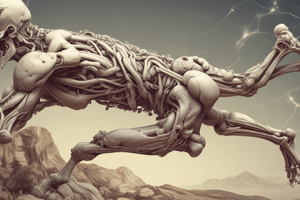Podcast
Questions and Answers
The study of the structure and organization of living organisms is known as ______.
The study of the structure and organization of living organisms is known as ______.
anatomy
The basic unit of life in the cellular level is the ______.
The basic unit of life in the cellular level is the ______.
cell
The mechanism that reverses a change in the body, such as regulating temperature, is called ______ feedback.
The mechanism that reverses a change in the body, such as regulating temperature, is called ______ feedback.
negative
The study of the functional changes associated with disease is referred to as ______.
The study of the functional changes associated with disease is referred to as ______.
The ______ system is responsible for facilitating gas exchange in the body.
The ______ system is responsible for facilitating gas exchange in the body.
Infectious diseases are primarily caused by ______.
Infectious diseases are primarily caused by ______.
The study of the cause or origin of a disease is known as ______.
The study of the cause or origin of a disease is known as ______.
The study of structures at the cellular level is referred to as ______ anatomy.
The study of structures at the cellular level is referred to as ______ anatomy.
Study Notes
Anatomy
-
Definition: Study of the structure and organization of living organisms.
-
Levels of Organization:
- Chemical Level: Atoms and molecules.
- Cellular Level: Cells, the basic unit of life.
- Tissue Level: Groups of similar cells performing specific functions.
- Organ Level: Structures composed of two or more tissue types.
- System Level: Groups of organs working together.
- Organism Level: The entire living individual.
-
Types of Anatomy:
- Gross Anatomy: Study of structures visible to the naked eye.
- Microscopic Anatomy: Study of structures at the cellular level (histology).
- Developmental Anatomy: Study of structural changes from conception through maturity.
Physiology
-
Definition: Study of the function of the body's structures.
-
Key Concepts:
- Homeostasis: Maintenance of a stable internal environment despite external changes.
- Feedback Mechanisms:
- Negative Feedback: Mechanism that reverses a change (e.g., temperature regulation).
- Positive Feedback: Mechanism that enhances a change (e.g., childbirth).
-
Systems of Physiology:
- Nervous System: Controls and coordinates body activities.
- Endocrine System: Regulates bodily functions through hormones.
- Cardiovascular System: Transports blood, nutrients, gases, and waste.
- Respiratory System: Facilitates gas exchange; oxygen intake and carbon dioxide removal.
- Musculoskeletal System: Provides support, movement, and protection.
- Immune System: Defends against pathogens and disease.
- Digestive System: Breaks down food and absorbs nutrients.
Diseases Foundations
-
Definition: Study of illnesses and conditions affecting the body.
-
Types of Diseases:
- Infectious Diseases: Caused by pathogens (bacteria, viruses, fungi).
- Non-infectious Diseases: Result from genetic, environmental, or lifestyle factors.
-
Common Terms:
- Pathophysiology: Study of the functional changes associated with disease.
- Etiology: Study of the cause or origin of a disease.
- Diagnosis: Identification of a disease based on signs and symptoms.
- Prognosis: Forecasting the likely outcome of a disease.
-
Prevention and Management:
- Preventive Measures: Vaccinations, healthy lifestyle choices.
- Treatment Options: Medications, surgeries, rehabilitation.
-
Importance for Health Professions:
- Understanding anatomy and physiology is crucial for diagnosing and treating diseases.
- Knowledge of disease foundations aids in developing effective treatment plans and preventive strategies.
Anatomy
- Definition: Study of the structure and organization within living organisms.
- Levels of Organization:
- Chemical Level: Involves atoms and molecules forming the basic building blocks of life.
- Cellular Level: Cells serve as the fundamental unit of life.
- Tissue Level: Comprises groups of similar cells carrying out specific functions.
- Organ Level: Structures made from two or more types of tissues working together.
- System Level: Groups of organs collaborating to perform complex functions.
- Organism Level: Represents the complete living individual.
- Types of Anatomy:
- Gross Anatomy: Investigates structures visible without the aid of a microscope.
- Microscopic Anatomy: Focuses on the fine detail of structures at the cellular level, known as histology.
- Developmental Anatomy: Examines the changes in structure from conception to maturity.
Physiology
- Definition: Study of the functions associated with the body's structures.
- Key Concepts:
- Homeostasis: The process that maintains a stable internal environment regardless of external fluctuations.
- Feedback Mechanisms:
- Negative Feedback: Mechanism aimed at reversing changes (example: regulation of body temperature).
- Positive Feedback: Mechanism designed to enhance changes (example: the process of childbirth).
- Systems of Physiology:
- Nervous System: Coordinates and controls body operations.
- Endocrine System: Manages bodily functions through hormonal signals.
- Cardiovascular System: Responsible for blood transport, carrying nutrients, gases, and waste products.
- Respiratory System: Enables gas exchange, supplying oxygen and removing carbon dioxide.
- Musculoskeletal System: Provides structural support, movement, and protective functions.
- Immune System: Defends the body against infectious agents and diseases.
- Digestive System: Facilitates food breakdown and nutrient absorption.
Diseases Foundations
- Definition: Exploration of illnesses and conditions impacting the body.
- Types of Diseases:
- Infectious Diseases: Arise from pathogens such as bacteria, viruses, and fungi.
- Non-infectious Diseases: Result from genetic predispositions, environmental elements, or lifestyle choices.
- Common Terms:
- Pathophysiology: Focus on functional changes associated with diseases.
- Etiology: The study of disease causes or origins.
- Diagnosis: The process of identifying diseases through observed signs and symptoms.
- Prognosis: Predicting the probable outcome or course of a disease.
- Prevention and Management:
- Preventive Measures: Include vaccinations and making healthy lifestyle choices to avert diseases.
- Treatment Options: Options such as medications, surgical interventions, and rehabilitation practices.
- Importance for Health Professions:
- Mastery of anatomy and physiology is essential for effective diagnosis and treatment of illnesses.
- Knowledge of disease foundations is vital for creating effective treatment regimens and preventive care strategies.
Studying That Suits You
Use AI to generate personalized quizzes and flashcards to suit your learning preferences.
Description
This quiz covers the fundamentals of anatomy and physiology, including the levels of organization in living organisms. It explores the branches of anatomy such as gross, microscopic, and developmental anatomy, as well as key physiological concepts like homeostasis. Test your knowledge on how structures and functions are interrelated.





